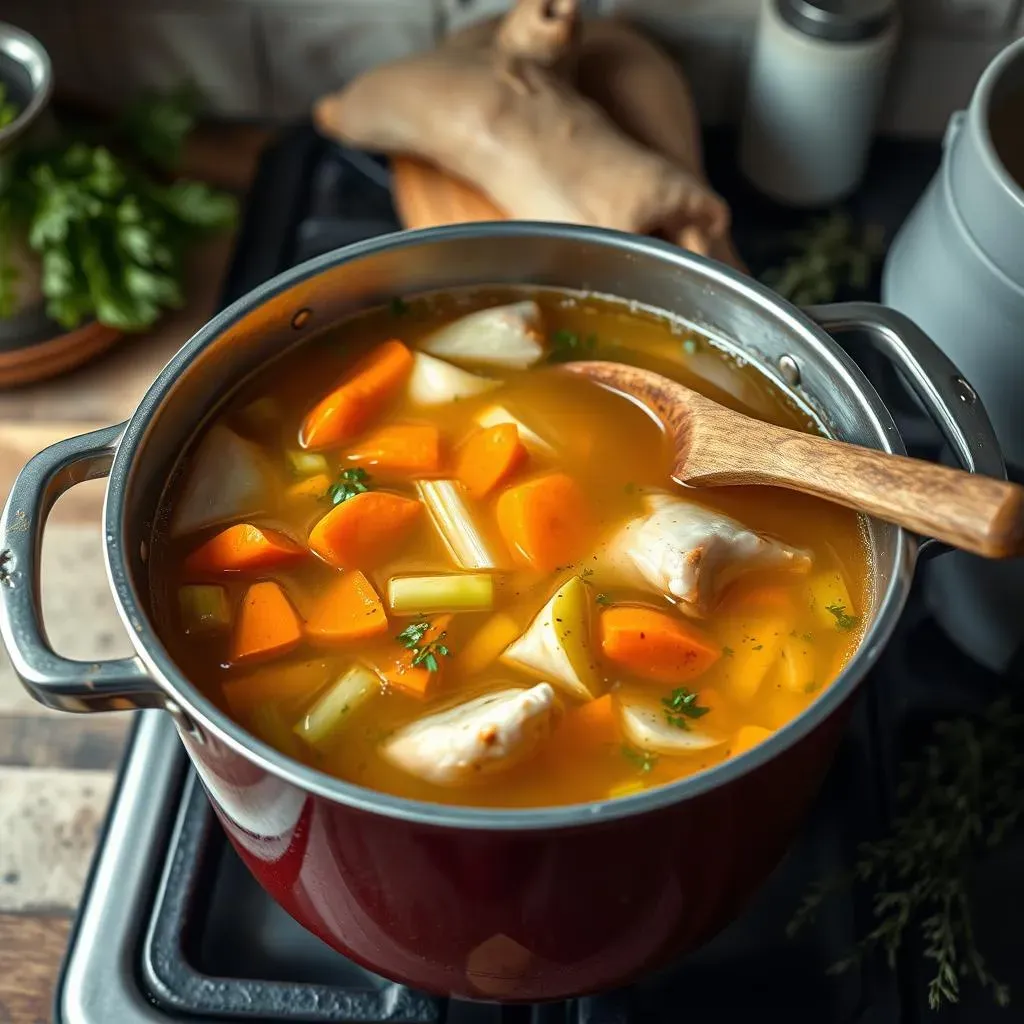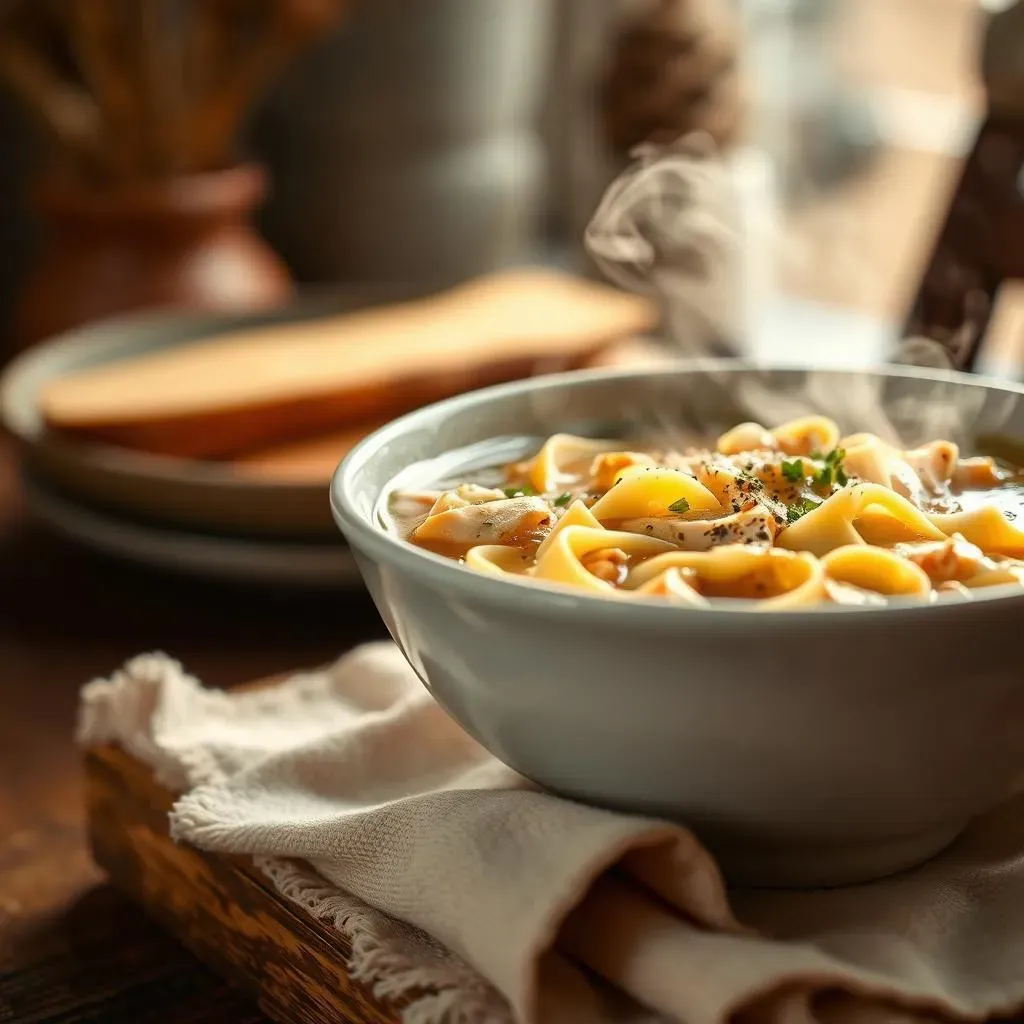Table of Contents
Are you ready to ditch the canned stuff and embrace the unbelievably delicious world of homemade chicken noodle soup with egg noodles? This isn't your grandma's recipe (unless your grandma was a culinary genius, in which case, hats off to her!). We're diving into the heart of this classic comfort food, exploring every delicious detail, from crafting the perfect broth to achieving noodle nirvana. Forget bland, watery soups – we're building a flavor explosion in a bowl! Get ready to learn the secrets to a truly exceptional homemade chicken noodle soup with egg noodles. We'll tackle everything from choosing the best broth (homemade or store-bought – the choice is yours!), to experimenting with different noodle types and discovering the magic of perfectly balanced herbs and spices. This isn't just a recipe; it's a journey to soup supremacy. So, grab your apron, gather your ingredients, and let's embark on this culinary adventure together. Prepare to be amazed by how simple and rewarding making homemade chicken noodle soup with egg noodles can be!
The Perfect Broth: From Scratch or StoreBought?

The Perfect Broth: From Scratch or StoreBought?
Homemade Broth: The Flavor Advantage
Let's talk broth, the soul of any good chicken noodle soup. Homemade broth is where the magic truly happens. It's a labor of love, sure, but the depth of flavor you achieve is unparalleled. Imagine simmering chicken bones, carrots, celery, and onions for hours, creating a rich, complex base that sings with umami. This is the foundation for a truly unforgettable soup. You get to control every ingredient, ensuring quality and freshness, avoiding unnecessary additives often found in store-bought broths. For a super simple approach, check out our recipe for homemade chicken noodle soup with rotisserie chicken – it’s a game-changer!
Think of it like this: homemade broth is to store-bought broth what a perfectly ripe tomato is to a jarred one. The difference is night and day. You'll taste the difference, your taste buds will thank you, and your soup will achieve a level of deliciousness that store-bought simply can't match. Plus, making your own broth allows you to control the sodium level, a big plus for health-conscious cooks. And if you're short on time, don't fret! You can totally make a big batch and freeze it for future soup adventures.
Ingredient | Flavor Contribution |
|---|---|
Chicken Bones | Richness, Collagen |
Carrots | Sweetness |
Celery | Savory notes |
Onions | Depth, complexity |
Store-Bought Broth: Convenience and Considerations
Now, let's be real. Sometimes, life gets hectic. You don't always have the time (or inclination) to simmer a pot of broth for hours. That's where store-bought broth comes in handy. It's a fantastic shortcut, allowing you to get a delicious soup on the table quickly and easily. There are tons of options available, from low-sodium broths to organic varieties. Just be sure to read the labels carefully, paying attention to sodium content and added ingredients.
The key here is selecting a high-quality broth with minimal additives. Look for broths with a clean ingredient list and a rich, flavorful profile. A good quality store-bought broth can definitely deliver a tasty soup, especially if you're short on time or prefer a quicker method. Don't underestimate the power of a good store-bought base combined with fresh herbs and spices to elevate your soup. For a speedy recipe, check out our quick homemade chicken noodle soup recipe. It's a lifesaver on busy weeknights!
- Read labels carefully
- Choose low-sodium options
- Look for minimal additives
- Consider organic options
Noodle Nirvana: Egg Noodles and Beyond

Noodle Nirvana: Egg Noodles and Beyond
The Classic Egg Noodle: A Timeless Choice
Let's start with the star of the show: egg noodles! These are the quintessential chicken noodle soup noodles. Their slightly chewy texture and subtle eggy flavor perfectly complement the rich broth and tender chicken. They hold up well in the soup, without becoming mushy, and provide a satisfying bite. For a truly authentic experience, consider making your own egg noodles from scratch! It's easier than you think, and the flavor payoff is immense. Check out our step-by-step guide to make homemade egg noodles.
But if you’re short on time, don’t worry. Store-bought egg noodles work just fine! Look for wide egg noodles for the best texture. Just be sure to cook them according to the package directions to avoid overcooking. Remember, perfectly cooked noodles are key to a great bowl of soup. Overcooked noodles are a culinary crime! Aim for that delightful *al dente* texture – firm to the bite, yet tender enough to enjoy.
- Wide egg noodles are ideal
- Cook until al dente
- Homemade noodles add extra flavor
- Store-bought are a convenient alternative
Beyond Egg Noodles: Exploring Other Options
While egg noodles reign supreme, don't limit yourself! The world of pasta is vast and varied. Consider experimenting with other noodle shapes and types to add some exciting variety to your soup. For a lighter, more delicate flavor, try using thin spaghetti or angel hair pasta. These will cook more quickly than egg noodles, but they add a nice textural contrast.
Feeling adventurous? Try using different types of noodles entirely! Rice noodles offer a delightful chewy texture and a subtly sweet flavor. If you're looking for a gluten-free option, rice noodles are a great choice. You can even explore using zucchini noodles (zoodles) for a low-carb, healthy twist – just be sure to add them towards the end of the cooking process to prevent them from becoming too soft. For more ideas, check out our zucchini noodle soup recipe.
Noodle Type | Texture | Flavor Profile |
|---|---|---|
Egg Noodles | Chewy | Subtle eggy flavor |
Spaghetti | Tender | Mild |
Rice Noodles | Chewy | Subtly sweet |
Zucchini Noodles | Tender-crisp | Mildly vegetal |
Flavor Fiesta: Vegetables, Herbs, and Spices

Flavor Fiesta: Vegetables, Herbs, and Spices
The Holy Trinity of Soup Veggies
Let's talk veggies! The classic chicken noodle soup trio – carrots, celery, and onion – forms the aromatic backbone of this dish. These aren't just filler; they contribute a delightful sweetness and savory depth. Carrots add a touch of natural sugar, celery brings a subtle earthiness, and onions provide a complex base flavor. Don't be afraid to experiment! Dice them finely for a smoother soup or leave them in larger chunks for a heartier texture. The choice is yours!
But why stop there? Feel free to expand your veggie horizons! Consider adding diced potatoes for extra heartiness, or some finely chopped leeks for a more sophisticated flavor profile. A handful of fresh or frozen peas adds a pop of color and a touch of sweetness. For a more robust flavor, try adding some chopped mushrooms or even some finely diced bell peppers. The possibilities are endless! For a recipe packed with fresh veggies, check out our recipe with extra vegetables.
Vegetable | Flavor Contribution | Texture |
|---|---|---|
Carrots | Sweetness | Tender-crisp |
Celery | Savory | Crisp |
Onions | Umami | Tender |
Herbs: A Symphony of Aromas
Now, let's talk about herbs – the secret weapon to elevating your soup from good to phenomenal. Fresh herbs are always best, but dried herbs work in a pinch. A classic combination is parsley, thyme, and bay leaf. Parsley adds a bright, fresh note, thyme contributes a warm, earthy flavor, and the bay leaf lends a subtle, almost mysterious depth. Don't overload on the bay leaf though – one or two leaves are usually enough. Remove them before serving.
But don’t be shy to experiment! A sprig of rosemary adds a lovely piney aroma. A pinch of oregano contributes a slightly peppery, herbaceous flavor. Fresh dill adds a bright, slightly citrusy note. If you’re feeling adventurous, try a small amount of finely chopped fresh sage or even a pinch of tarragon. The key is balance. Start with small amounts and adjust to your taste. For a soup bursting with fresh herb flavors, check out our recipe using fresh herbs.
- Parsley
- Thyme
- Bay leaf
- Rosemary
- Oregano
Spices: A Pinch of Perfection
Finally, let's talk about spices – the finishing touch that takes your soup from delicious to extraordinary. A little salt and pepper are essential, enhancing the natural flavors of the broth and ingredients. But don’t be afraid to experiment with other spices to add complexity and depth. A pinch of black pepper adds warmth and a touch of spiciness. A dash of garlic powder or onion powder adds an extra layer of savory flavor.
For a more exotic twist, consider adding a pinch of turmeric for a vibrant color and a subtle earthy flavor, or a dash of paprika for a smoky, sweet note. A tiny pinch of cayenne pepper adds a subtle kick. Remember, less is more when it comes to spices. Start with small amounts and adjust to your taste. The goal is to enhance the natural flavors of the soup, not to overpower them. And for those who like a little heat, try adding a dash of hot sauce at the end. For a healthier option, check out our healthy recipe.
“The best spice is a touch of love.” – Anonymous
